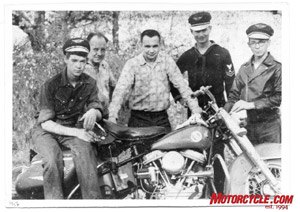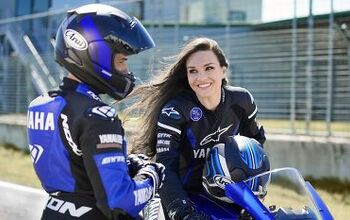Master Restorer Bob Davis
You could describe Bob Davis as master tool-and-die machinist, a restorer of vintage motorcycles and automobiles, a pilot, a musician, and also an innovator who helped millions bake a better cupcake. It all started while jostling around in the bottom of a sidecar some 80 years ago.
“My mother carried me in a sidecar between her feet when I was a baby,” says Bob. “This was in Pana, Illinois, about 30 miles south of Decatur where my Dad was a blacksmith and a horseshoer. We rode around in a four-cylinder Ace sidecar rig as we couldn’t afford a car then and it was our family transportation. My Dad bought, sold and traded motorcycles all his life. Our whole family including my mother and three brothers and four sisters all rode motorcycles.”
At 14 Bob would ride his first bike, a 1925 Harley-Davidson JD. “It belonged to my cousin, but I worked on it so he let me ride it. I ended up buying it from him for a whopping $50. It had several mechanical indigestion problems but I sorted them out.”
His next project was a four-cylinder Indian bought as a basket-case with a broken crankcase. “Dad showed me how to jig it up and we welded it with an acetylene torch.” Then there was a dry spell during which he was without a bike, but that changed one day when a customer showed up at his father’s blacksmith shop. He needed his plough sharpened and offered an old Harley in barter. “It was a 1915 with its engine out, but there were parts to build two bikes. I said, 'Well, okay,' and made the deal while my Dad was out at a job.
“He came back and found the pile of motorcycle parts. He said, 'Where the hell did all this come from?' I told him I had traded the plough sharpening job for the Harley parts. He was mad. He was an Indian rider and had nothing to do with Harleys. He said, 'Well, I hope you don’t plan to get it running and park it in my yard.' I put the thing together and he made me park it behind the coal shed. Then I came home one day and the Harley was gone. 'Oh, no, he’s sold my bike!' I thought. Then I hear a motorcycle chugging and there was my Dad riding the bike. He was smiling, sort of. He said, 'It don’t ride bad for a Harley, but you still can’t park it in my yard.'”
Despite the prohibition about Harleys, Bob would learn a wide spectrum of skills from his father including the machinery and blacksmith trade as well as carriage making, and by 16 he had served his apprenticeship. He and his father kept dabbling in motorcycles until Bob entered the Navy during WWII where he applied his skills in a naval shipyard and rode about on an Indian Scout he bought for $15 because it was a non-runner at the time he bought it.
While he was attached to Indians he also developed an inclination for British bikes, and in 1947 he went to work at the Elgin Cycle Company in Palatine, IL. Elgin sold Ariel, BSA, Douglas, Triumph, Vincent and Indians. “I rode my first Ariel at the time, a 21-cubic-inch single-cylinder Red Hunter. I fell in love with the thing as it ran so nice. I had it about two weeks when a lady backed over it with a Packard and bent it all out of shape.” Bob sent the frame to Buchanan’s in California, and was able to rebuild it. As we shall see, both Ariels and Packards would figure into Bob’s future.
While in high school and dating his wife-to-be Virginia, he would squire her around on a 1948 Ariel Square Four. “I stopped by her father’s house to ask permission to take her roller skating on Sunday afternoon on my Ariel. He said, I guess it’s all right; you can’t get into too much trouble on a motorcycle. Little did he know,” laughs Bob.
Eventually Bob would take over the bike shop where he had been employed.
“We sold a lot of Indians back then, but we were also selling the new Triumph Speed Twins and Tigers at the rate of one a day.” After about two years he took a fork in the professional road when he enrolled in school to study tool, die and gauge making as well as both mechanical and plastic engineering. During the mid-1950s he would go on to pioneer, among other things, the design and manufacture of plastic egg cartons, Styrofoam drinking cups, as well as aluminum foil products including the pans we all use to bake cookies and cakes. But he was also still cooking up motorcycles and riding a KJ Henderson.
A few years later Suzuki came out with their now famous 250cc two-stroke X-6 Hustler and Bob began spending time in a shop that started selling the bikes as well as Marushos, basically Japanese copies of the BMW. “The Marushos were a flop, but we sold the fire out of the Suzukis. At the time I was riding one of the X-6 bikes, but then I found the 500cc single Ariel Model G Special. That would be the spring of 1963 and I’ve had it since. I bought it from a Triumph flat-tracker after fixing his gearbox. We pulled it out a chicken coop where it had sat for several years. I put air in the tires, poured some gas in the tank, popped it off and rode it home.”
The complete restoration would wait five years until Bob moved from Illinois to Mountain Home, Arkansas, where his sister owned a store. After a visit, they liked the place so much that they would call it their new home, residents now for some 30 years. “It’s got some nice hilly, twisty roads to ride motorcycles,” says Bob who also opened his Mountain Home Machine Shop where he began accumulating a wide range of motorcycles, everything from a new Goldwing to a 1934 Indian-4, serial #1.
Over the years he’s helped out a slew of people whose bikes had “mechanical indigestion problems,” and also hand fabricates replacement parts for antique and vintage BMWs. Basically the impossible stuff to find including valve lifter guides, pushrod tube installation tools, bronze bearing carriers for engines, transmission gears, etc., with much of the parts going to Craig “Vech” Vechorik at Bench Mark Works in Sturgis, MS. In fact, during one of our interviews he was rebuilding the gears for a 1928 BMW for Vech.
We mentioned earlier that a Packard would resurface some 50 years after his first Ariel was crunched by one. It seems that Bob’s skills were called upon to restore Juan and Eva Peron’s 1939 Dual Cowl Phaeton Packard, a five-year project after the car was brought out of Argentina after many years of neglect and rust. While it now resides in a private collection, you might have seen it cruising about in the film “Evita.”
Bob, who just turned 80, can be found at his machine shop six days a week. He also attends the Davenport event as well as the annual vintage BMW rally held by Bench Mark Works. At the moment he’s restoring a 1928 water-cooled two-stroke Scott. Bob’s son Paul who lives in Savannah, GA has also become a full machinist, and son Sam who lives in Springfield, MO, is also a machinist and fabricator, and both are motorcyclists. The Bob Davis tradition carries on.
More by Paul Garson


































Comments
Join the conversation